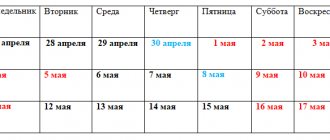Duration of vacation: 28 calendar days or working days?
Each employee, based on the Labor Code of the Russian Federation, is entitled to leave once a year.
Depending on the profession, rest can last a different amount of time, but not less than 28 days. We’ll look at which 28 days count towards vacation – calendar days or working days – in the article.
Legislative regulation According to the Labor Code, Article 115, the employer must pay at least 28 days per year.
No matter what disputes this may cause, the employee is paid and provided with calendar days. If the vacation falls on non-working holidays, then they are not included in its duration and are paid, which is regulated by Article 120 of the same Labor Code.
More information about holidays that fall on holidays can be found in this article.
Let's look at an example of how to calculate vacation:
- Manager Karpov decided to rest and wrote an application for leave from April 10 to April 17. During these 7 days there are 2 days off - Saturday and Sunday. Karpov is paid for all 7 days in a row and all of them are included in vacation. If Karpov writes an application for leave for the period from May 7 to May 14, then only 7 days will be counted towards the vacation, since May 9 is a holiday.
The time that a vacationing employee spent on sick leave is not included in the calculation of vacation if he submits a sick leave certificate to the payroll department. The period of incapacity spent on vacation extends the duration of rest by the number of days of illness. Watch the video about the nuances of granting vacation: Additional days 28 days is the minimum vacation period established by the Labor Code.
An employer can also establish a longer vacation for its employees. The number of additional days paid by the employer is stipulated in the collective labor agreement or in individual labor contracts, as well as in local regulations. Additional vacation days are provided to certain categories of employees:
- Working disabled people, civil servants, prosecutors and investigative officers must rest for at least 30 calendar days. Minors have at least 31 calendar days of rest. Employees of medical organizations working with HIV-infected people have 36 working days of rest. Emergency rescue services employees have the right to rest from 30 to 40 calendar days. Candidates of Sciences can rest for 36 working days. Doctors of Science are entitled to 48 working days leave. Teachers rest for 42 or 56 calendar days. Specialists working with chemical weapons rest for 49 or 56 calendar days.
In addition, there is also the concept of northern additional leave, which is regulated by Article 321 of the Labor Code.
It also has different durations: for those working in the Far North - an additional 24 calendar days; for those working in places equated to the Far North - another 16 calendar days; in other northern regions - an additional 8 days.
Extended and additional leave
- for those working in the Far North – an additional 24 calendar days;
- for those working in places equated to the Far North - another 16 calendar days;
- in other northern regions - an additional 8 days.
According to Article 116 of the Labor Code, additional leaves are also provided to employees:
- with irregular working hours (usually from 3 calendar days);
- working in hazardous industries (usually from 7 calendar days);
- workers on jobs of a special nature (from 3 working days or more), etc.
At the employer's discretion, additional leave may be granted to those working in other jobs.
Why and under what conditions this is done is stated in the collective labor agreement or in local regulations.
The principle for calculating the duration of additional leave does not differ from the calculation of the main one. That is, holidays are not included in it.
The collective labor agreement may stipulate the possibility for certain categories of employees to take unpaid additional leave. Usually these are working pensioners, disabled people, single mothers and other categories.
The law provides for this possibility, but the decision on this issue is left to the discretion of the employer. In the event of the birth of a child, for registration of marriage, due to the death of close relatives, unpaid leave of up to 5 calendar days is granted.
Division into parts
Both the main vacation and the additional one can be combined into one. If desired, the entire vacation can be split into parts. To do this, 2 conditions must be met:
- there must be an agreement between the employee and the employer;
- one part of the vacation per year must be at least 14 days.
For example, laboratory assistant Afanasyeva has the right to basic leave of 28 calendar days and additional leave for harmful activities of 7 calendar days.
We invite you to read: Simplified subsidies are taxable
Afanasyeva can take 15 days off in the summer, then take another 10 days off from August 25 to September 3 to get her child ready for school. She will still have 10 days of vacation left to go skiing in December.
The law allows you to take one long vacation per year (lasting at least 14 days), and break the rest into as many parts as you like. In this regard, it becomes profitable for employees working at 5 to take vacation for 5 days of the work week from Monday to Friday, and then take another 2 days off without including them in vacation.
This way you can save as much as 2 calendar days of vacation each week.
If the vacation is 28 days (that is, it includes 4 Saturdays and 4 Sundays), then you can do the following:
- Take 14 days off.
- After 2 months, take 5 days from Monday to Friday.
- After a couple of months, take another 5 days from Monday to Friday.
- There are still 4 reserve calendar days left, saved on the weekend.
Vacation is shared only by agreement with the employer! That is, the employer may not agree to such a division.
Since there is no minimum unit for taking vacation, many employees take 2 days of vacation, for example, before the weekend or before holidays.
After 6 months of continuous work with a particular employer, the employee receives the right to paid leave. An employee can request leave from the employer before this period. In this case, vacation is not calculated in proportion to the time worked, but is provided in full, and the employer pays for all days of vacation.
An employer does not have the right to impose a vacation of 14 calendar days on an employee. If the employee subsequently resigns before a year has elapsed from the start of employment, the portion paid for the excess leave granted is withheld from his payment.
In subsequent years of work, vacation is provided in accordance with the vacation schedule, which is drawn up taking into account the wishes of the employee. Study leaves do not have any impact on the main leave.
In conclusion, it can be noted that an employee can demand that the employer provide him with full leave - no matter how long it may be. The employer cannot refuse to satisfy his legal requirements.
Division of vacation is allowed only by mutual agreement of the parties.
Vacation from 02/10/14 to 03/03/14.
When to go to work on March 03 or 04?
Hello! Please tell me, I am on vacation from 02/10/2014 to 03/03/2014.
The order says for 21 calendar days.
I can’t figure out when to go to work? March 3rd or March 4th? (since 23.02. is a holiday and it falls on vacation, the vacation should be postponed???) March 01, 2014, 23:29, question No. 384278 Oksana, Izhevsk Collapse Online legal consultation Response on the site within 15 minutes Answers from lawyers (2) 751 answers 557 reviews Chat Free assessment of your situation Lawyer,
Rostov-on-Don Free assessment of your situation Dear Oksana!
If the order says vacation from 10.02 to 03.03. This means he has to go to work on March 4th. As for the rest, here you already deal with the personnel.
Give your reasons. Article 120 of the Labor Code of the Russian Federation will help you. But don’t forget about postponing some weekends due to February 23rd to May.
Article 120. Calculation of the duration of annual paid vacations The duration of annual basic and additional paid vacations of employees is calculated in calendar days and is not limited to a maximum limit. Non-working holidays falling during the period of annual main or annual additional paid leave are not included in the number of calendar days of vacation. I hope for your positive feedback. March 01, 2014, 23:45 1 0 10138 replies 4010 reviews Chat Free assessment of your situation Lawyer,
Kaliningrad Free assessment of your situation You have been granted leave in calendar days.
By definition, it doesn't matter whether holidays fall on vacation or not. After all, your vacation was not given in working days, so you can subtract holidays and weekends from it. The 21-day vacation will end on March 2. So, March 3 – back to work. True, it is not clear whether the order was written incorrectly, or whether you wrote it incorrectly.
There is a fundamental difference in how leave is granted - on March 3 or until March 3.
The preposition “by” means that March 3 is included in vacation. "Before" - does not turn on. And if the order says that vacation “until March 03,” this means that you should go to work on March 04. But in this case, your vacation is not 21, but 22 working days.
Which contradicts the order granting 21 days of leave. 01 March 2014, 23:46 0 0 All legal services in Moscow Best price guarantee - we negotiate with lawyers in every city on the best price.
Similar questions 14 June 2020, 12:54, question No. 1283718 02 May 2016, 11:20, question No. 1239501 12 January 2020, 12:56, question No. 1096159 05 June 2013, 18:23, question No. 96970 17 February 20 20, 19:07, question No. 1148071 See also
If an employee goes on vacation from December 20 to 21 calendar days, are all the days of the Christmas holidays postponed and the vacation extended?
Only non-working holidays are not included in vacation days, namely 8 days of the New Year holidays, including Christmas. In this case, it does not matter whether employees have a five-day or six-day working week; holidays are established for all workers.
Holidays provided for (in the current version) of the Labor Code of the Russian Federation are not included in the number of calendar days of vacation, and the employer does not pay for them. In this case, if the vacation coincides with the New Year holidays, there are 8 such days (1, 2, 3, 4, 5, 6 and 8 January - New Year holidays; January 7 - Christmas Day, i.e. the employee will actually be absent from work more than 8 days compared to the original duration of vacation, but the specified 8 holiday days will not be paid.
Regular days off in January are: for a five-day work week: January 11, 12, 18, 19, 25 and 26. And with a six-day working week only: January 12, 19, 26, 2014.
For example, an employee asks to be granted leave from December 20, 2013 for 21 calendar days.
The order will indicate that the employee is granted leave from December 20, 2013 to January 17, 2014, but for 21 calendar days.
The employee must begin work on the next working day. So, if an employee has a six-day work week, then he will need to start work on Saturday, January 18, 2014, and if it is a five-day work week, then on Monday, January 20, 2014.
As a general rule, if a weekend and a holiday coincide, the day off is transferred to another working day. At the same time, the status of the day as a holiday is preserved. In your case, January 4 and 5 are the days of the New Year holidays, i.e. holidays. In order to make optimal use of rest time, weekends that coincide with the New Year holidays are transferred to other days by government decree.
It is not holidays that are subject to transfer, but weekends (Saturday and Sunday). The transfer was carried out: from Saturday January 4 to Friday May 2; Thus, we consider May 2 as a day off - according to the rules of working on Saturday; from Sunday 5 January to Friday 13 June.
Thus, we consider June 13th as a day off - according to the rules of working on Sunday. The fact that the weekends from January 4th and 5th have been moved to May and June 2014 will not have any additional effect on the duration of the vacation in this case. Details in the System materials:
- Situation: How to determine the duration of an employee’s vacation in connection with the postponement of days off that coincide with holidays
When determining the duration of vacation for an employee in a month with holidays, use the general rules for extending vacation on non-working holidays that fall during the vacation period ().
Only the number of non-working holidays mentioned in Article 112 of the Labor Code of the Russian Federation, and not the weekends postponed by the Government of the Russian Federation that coincided with holidays, should be extended or excluded from its duration. Rescheduled days off in general according to the order of calculation
Read online “The Feat of a Soldier [Stories]” by Mityaev Anatoly Vasilievich – RuLit – Page 10
“There were no other circumstances,” Golov answered, closing his eyes and falling asleep. - What’s funny is that it’s not my fault...
Four hours leave
The soldier most often had to fight far from home. His house is in the mountains in the Caucasus, and he is fighting in the steppes of Ukraine. Home is in the steppe, and he is fighting in the tundra near the cold sea. No one chose the place where to fight. However, it happened that a soldier defended or recaptured his hometown, his home village from the enemy. Vasily Plotnikov also ended up in his native land. After the battle ended and the Nazis retreated, the soldier asked the commander for permission to go to the village of Yablontsy. His house is there. There is a wife with a little daughter and an old mother. Yablontsi is only ten kilometers away.
“Okay,” said the commander. - I give you, Private Plotnikov, leave for four hours. Come back without delay. It’s eleven now, and at fifteen the trucks will arrive, we’ll go to new positions.
Plotnikov’s comrades brought their food supplies - canned food, crackers, sugar. They put everything in his duffel bag. Let him treat his family. The gifts are not great, but from the bottom of my heart! They were a little jealous of Plotnikov. It's no joke - I haven't seen my relatives for two years, I didn't know anything about the family, and now - a quick date. True, the soldiers also thought that Plotnikov’s wife, little daughter, and old mother could have died in fascist captivity. But they did not express their sad thoughts out loud.
And Vasily Plotnikov thought about this himself. And therefore his joy was alarming. He said only one word to his comrades: “Thank you!”, put the straps of a duffel bag on his shoulders, hung a machine gun around his neck and walked straight across the field, through the forest to Yablontsy.
The village of Yabluncy was small, but very beautiful. The soldier Plotnikov often dreamed of her. Under tall old willow trees, like under a green tent, in the cool shade stood strong houses with carved porches and clean benches in front of the windows. There were vegetable gardens behind the houses. And everything grew in these gardens: yellow turnips, red carrots, pumpkins that looked like leather balls, sunflowers that looked like brass basins, polished to a shine, in which jam was made. And behind the vegetable gardens there were gardens. Apples ripened in them - whatever you want! Sweet and sour pears, terentyevkas as sweet as honey and the best Antonov apples in the whole world. In the fall, when they soaked the Antonovka in barrels, when they put it in boxes for winter storage, overlaying the layers with rye straw, everything in Yablontsy smelled of apples. The wind, flying over the village, was saturated with this smell and carried it far around the area. And people—either passers-by or travelers whose path was away from Yabluntsy—turned off the road, came in, drove in, ate plenty of apples, and took them with them. The village was generous and kind.
Vasily Plotnikov was in a hurry. The sooner he reaches the village, the more time he will have to meet with his family. All the paths, all the paths, all the ravines and hillocks were known to him since childhood. And then, a little over an hour later, he saw Yabluncy from a high place. Saw. Has stopped. I looked.
There was no green tent over Jablunci. Instead, a black, tattered web was stretched in the sky: the leaves on the tall willows were burned, the branches were also burned, and the branches were charred, and they lined the sky with a black web.
Soldier Vasily Plotnikov’s heart sank and ached. With all his strength he ran to the village. As if he wanted to help his Yablon residents with something. And nothing could be done to help. Jabluncy became ashes. The calcined earth was covered with sulfurous ash, like road dust, and strewn with firebrands.
Among this ashes stood smoky stoves with tall chimneys. It was unusual and creepy to see brick pipes of such height. Previously, they were covered with roofs, and no one had ever seen them like that. The ovens seemed like living creatures, some kind of huge birds stretching their long necks into the empty sky. The birds wanted to fly up at the terrible moment, but did not have time and remained, petrified, in place.
Before the fire, Vasily Plotnikov’s house stood in the middle of the village. The soldier easily found and recognized his stove. The whitewash showed through the soot. He whitewashed the stove himself before he went to war. Then he did a lot of other work around the house - to make life easier for his wife, mother and daughter. “Where are they now? What happened to them?
Vote:
Category: Answers: 17 You can add a topic to your favorites list and for notifications by mail.
[email hidden] Russia, St. Petersburg Wrote 298 messages Reputation:
May 24, 2011, 10:56 No ratings The employee goes on vacation from May 30 to June 19, and returns to work on June 20.
But due to the fact that June 12 is a holiday, the vacation should last until June 20 and the return to work will be on June 21.
How can an employee rewrite the application (what dates to put) so that he actually rests from May 30 to June 19 and takes into account the holiday? I want to draw the moderator’s attention to this message because:
A notification is being sent.
Russian Federation, Kursk Wrote 11079 messages Reputation: May 24, 2011, 11:00 An employee can simply write: “I ask you to grant me annual leave from May 30.” And it’s correct to calculate the number of vacation days taking into account the holiday - your job, and familiarize the employee with dates in the order.
I want to draw the moderator's attention to this message because: A notification is being sent.
[e-mail hidden] Russia, Saratov Wrote 2045 messages Reputation: May 24, 2011, 11:01 “I ask for leave for 21 calendar days from May 30, 2011.” Then, when counting days, the holiday will not be included in the calendar number of vacation days, and the employee will return to work on June 21.
Or write an application for 20 calendar days, then the employee will return to work on June 20.
I want to draw the moderator's attention to this message because: A notification is being sent.
[e-mail hidden] Russian Federation Wrote 1130 messages Reputation: May 24, 2011, 12:16 They write to us: I ask for a vacation of 20 calendar days from May 30 to June 19.
I want to draw the moderator's attention to this message because: A notification is being sent.
[email hidden] Russia, Saratov Wrote 2045 messages Reputation: May 24, 2011, 12:29 pm I would like to draw the moderator's attention to this message because: A notification is being sent.
[e-mail hidden] Russian Federation, Moscow Wrote 1731 messages Reputation: May 24, 2011, 12:34 Katerinka wrote: “I ask for leave for 21 calendar days from May 30, 2011.” Then, when counting days, the holiday will not be included in the calendar number of vacation days, and the employee will return to work on June 21.
Sample application
Sample application for annual paid leave of two weeks:
General Director of JSC "Vkusnyashka"
Korovaev A.A.
purchasing department specialist
Voronova Victoria Alekseevna
Statement
Please provide me with annual basic paid leave of 14 calendar days from 11/25/2019 to 12/08/2019.
06.11.2019 (signature) V.A. Voronova
An example of an application for dividing the main leave not in accordance with the approved schedule:
To the director
Tomilov A.A.
Accounting department specialist
Selevanova Anastasia Viktorovna
Statement
I ask you to provide me with annual paid leave for 10/11/2018-10/11/2019, lasting 28 calendar days, not in accordance with the approved vacation schedule for 2020, in the period 12/02/2019-12/29/2019, but in parts in this order:
- from November 25, 2019 to December 8, 2019 (14 calendar days);
- from 12/16/2019 to 12/29/2019 (14 calendar days).
Grounds for dividing leave: the need to be present at the workplace during the period from December 9 to December 14, 2020.
11/07/2019 (signature) A.V. Selevanova
A sample application for leave for 14 calendar days is available.
It is recommended that such an application be submitted to the employer for consideration two weeks before the start date of the vacation. If the director of the company agrees to the proposed division of leisure, then he puts forward a corresponding resolution. An order is issued based on the application. It is drawn up according to the standard T-6 form, approved by Decree of the State Statistics Committee of the Russian Federation No. 1 of January 5, 2004.
The document must contain the following information:
- order number;
- date of drawing up the order;
- Personnel Number;
- Company name;
- Full name of the employee;
- position and structural unit of the employee;
- start and end dates of vacation;
- type of holiday provided;
- Full name of the head of the organization and his signature.
The T-6 order form to fill out is given below.
Usually the manager's secretary is responsible for drawing up orders. The director of the company checks the finished order and signs it. With this he approves the publication of the document. The employee is introduced to the order against signature. After this, the subordinate can go on vacation on the dates specified in the order.
For 5 calendar days or days as correct
The ending extension must be one-letter if the last letter of the numeral in this case is preceded by a vowel sound (“first, second”), and two-letter if the last letter of the numeral in this case is preceded by a consonant sound (“first, second”). Three-letter extensions are a mistake. 2 boys and 10 girls two boys and 10 girls Numerals less than 10 are written in words, numbers from 10 and above are written in numbers.
school No. 3 school No. 3 The icon and number replace words, so a space is required between them; words in Russian are always separated by spaces: “school number three”, not “school number three”. 2.5 million rubles 2.5 million rubles It reads “two point five million.” girls 17 years old from 56 regions girls 17 years old from 56 regions Incremental case endings are added only to ordinal numbers.
Also, the Labor Code of the Russian Federation does not say anything about how many calendar days should fall on weekends and how many on working days.
Therefore, when using vacation in parts, vacation days can fall on both weekdays and weekends. Are there any restrictions on dividing vacation into parts?
But, in addition to the possibility of dividing vacation into parts, Article 125 of the Labor Code of the Russian Federation also establishes restrictions - division of vacation is possible only by agreement between the employee and the employer. Thus, if an employee wants to take vacation in parts, he will have to agree with his boss on its duration, because
The employer reserves the right to disagree with this option for splitting the vacation. After all, from the employer’s point of view, such a breakdown of vacation into parts is not rational. Moreover, annual paid leave can be divided into parts only by agreement between the employee and the employer.
However, there are no requirements for the duration of the remainder of the leave.
Thus, it turns out that the employee is not prohibited from splitting the second half of the vacation at his own discretion, having agreed on the duration of each part with the employer. Therefore, if the employer does not object, the employee has the right to take leave for 5 calendar days (without days off).
Moreover, with the consent of the employer, the employee can rest several times for 2-3 days. It is possible to use annual leave in another way: first, divide 14 calendar days into several periods of rest, and then apply for the remaining 14 days at a time.
Attention We also recommend that you read the letter of the Federal Service for Labor and Employment dated July 17, 2009.
N 2143-6-1. For information: As a general rule, an employer is an individual or legal entity (organization) that has entered into an employment relationship with an employee (part four of Article 20 of the Labor Code of the Russian Federation). If an organization has entered into labor relations, the rights and obligations of the employer in labor relations are exercised by its management bodies or persons authorized by them in the manner established by the Labor Code of the Russian Federation, other federal laws and other regulatory legal acts of the Russian Federation, laws and other regulatory legal acts
What it is
There is no concept of “time off” in labor law, so when writing an application there must be a request for an additional day of rest. As a rule, it is allocated through paid leave or leave provided at one's own expense, which is not paid. In both situations, in accordance with labor legislation, the employee has the opportunity to legally miss a day of work.
Time off is rest time that is provided to employees as compensation for overtime work.
If it is provided for the fact of going to work full time, then its duration does not matter. Time off is provided for the next two weeks. If an employee worked on a weekend or holiday, the work time is compensated for 10 days.
The legislative framework
In accordance with Article 153 of the Labor Code, an employee is given an additional day off for performing work outside the established working hours, that is, in excess of the time specified by labor standards. To exercise this right, he must write an application if he has time worked. By agreement of the parties, time off instead of a day off can be compensated in cash in double amount. Although Article 64 of the Labor Code provides for the provision of another day for rest.
Issues of compensation for time worked are regulated by Articles 88-89 of the Labor Code, which stipulates not only the provision of time off, but also the amount of payment for work performed. Article 89 states that compensation for overtime work cannot be provided by time off. If the parties have agreed in advance to grant time off, then the order or instruction on engaging the employee to perform work outside the established time shall indicate the time allotted for rest.
If an agreement on time off is reached between the employer and the employee, it can be added to the labor leave, which is provided annually according to the schedule.
The employer is obliged to provide leave without pay in accordance with Article 128 of the Labor Code at the request of the employee in cases provided for by law . In other cases, he has the right to refuse the employee’s request, regardless of the reasons that led to the need for release from work during working hours. Time off can be paid in accordance with labor law standards if the employee previously worked for some time.
One of these cases includes the provision of unpaid leave until:
- 35 days a year if the employee is a participant in hostilities;
- 5 working days for the birth of a child, the death of a close relative, for wedding celebrations;
- 60 days for a working disabled person, regardless of the reason;
- 14 days for a working pensioner;
- 14 days for an employee who is the husband, wife or parent of a military serviceman, if he died during hostilities as a result of a serious illness received during military service.
But the employee is granted the right to receive leave in accordance with Article 122 of the Labor Code after six months during which he continuously worked for the employer.
Getting married is a good reason to be absent from work. Find out. what the Labor Code says about time off for a wedding. What documents are needed to open a cafe? Read in the article.
vacation
Question asked on March 29, 2013 at 20:58, the employee completed the application on April 29, 2013.
for 22 calendar days. How many days will it increase due to the coincidence of its holidays and holidays in May and taking into account the transfer of weekends from January 2013? Thanks eduard Published March 29, 2020 at 9:14 pm Published March 29, 2020 at 9:14 pm Good afternoon!
Non-working holidays falling during the period of the annual main or annual additional paid period are not included in the number of calendar days. In May, non-working holidays are the 1st and 9th. Thus, they are not included in the number of calendar days.
Yours will last until May 20, 2013. inclusive. Love_ Published on March 30, 2020 at 12:45 pm Published on March 30, 2020 at 12:45 pm Hello! The vacation will last from April 29 to May 22, 2013 inclusive.
May 1 and May 9 will be increased by two unpaid days. You can do the math yourself: April 29 is Monday. We count the weeks. From April 29 to May 19, 2013 inclusive - 3 weeks, or 21 calendar days.
We are adding one more day, May 20th. Total -22 calendar days. But we have 2 holidays, so we add 2 more days - May 21 and 22.
nataldream Published March 30, 2020 at 1:14 pm Published March 30, 2020 at 1:14 pm Hello! Until May 22 inclusive. The number of days of the annual a does not include exclusively non-working holidays, named in Article 112 of the Labor Code, i.e. 01 and 09 May. March 29, 2013 March 29, 2013 March 29, 2013 March 29, 2013 March 29, 2013 March 29, 2013 Made in St. Petersburg © 1997 - 2020 PPT.RU Full or partial copying of materials is prohibited, with agreed copying a link to the resource is required Your personal data is processed on the site for the purposes of its functioning.
If you do not agree, please leave the site. Are you sure you want to remove the image you're using and replace it with your default avatar?
Are you sure you want to go out?
The employee was granted regular paid leave from 07/07/2003 for a period of 21 calendar days.
In April, the organization paid the insurance company, in accordance with the collective agreement, the amount of insurance premiums under voluntary insurance contracts for employees. How to calculate the amount of average earnings saved during an employee’s vacation?
Entire site Legislation Standard forms Judicial practice Explanations Invoice Archive An employee of a trade organization was granted another paid leave from 07/07/2003 for a period of 21 calendar days. According to the staffing table, the employee’s salary is 10,000 rubles.
The collective agreement stipulates that the organization annually pays the insurance company the amount of insurance premiums under voluntary personal insurance contracts for employees, which provide for payment by the insurance company of medical expenses of the organization's employees.
In April, the organization paid insurance premiums under the above personal insurance contracts for the period from 04/01/2003 to 04/01/2004 in the amount of 6,000 rubles. for each employee. How to calculate the amount of average earnings saved during an employee’s vacation? In accordance with Articles 114 and 115 of the Labor Code of the Russian Federation, employees are granted annual vacations lasting 28 calendar days with preservation of their place of work (position) and average earnings. The amount of average earnings saved during vacation (vacation pay) is calculated based on the average salary, for the calculation of which Article 139 of the Labor Code of the Russian Federation establishes a unified procedure, the specifics of which are determined by the Regulations on the specifics of the procedure for calculating the average salary, approved by the Decree of the Government of the Russian Federation dated 11.04. 2003 N 213 (hereinafter referred to as the Regulations).
To calculate the average salary, all types of payments provided for by the remuneration system and applied in the relevant organization are taken into account, regardless of the sources of these payments (Article 139 of the Labor Code of the Russian Federation).
In this case, such payments include wages accrued to the employee in accordance with the official salary for the time worked (clause "a" clause 2 of the Regulations).
Remuneration is a system of relations related to ensuring that the employer establishes and makes payments to employees for their work in accordance with laws, other regulations, collective agreements, agreements, local regulations and employment contracts. Wages are remuneration for work depending on the employee’s qualifications, complexity, quantity, quality and conditions of the work performed, as well as compensation and incentive payments (Article 129 of the Labor Code of the Russian Federation). The salary of each employee depends on his qualifications, the complexity of the work performed, the quantity and quality of labor expended (Article 132 of the Labor Code of the Russian Federation).
Based on the above definitions, in accordance with labor legislation, the payment by the organization of insurance premiums under personal insurance contracts for employees provided for by the collective agreement is not payment for their labor, since its amount does not depend on the qualifications of the insured employee, the complexity, quantity, quality and conditions of the work performed by him. Thus, despite the fact that the list of payments taken into account for calculating average earnings is not closed (paragraph "n" clause 2 of the Regulations), the amount of the specified insurance contributions, in our opinion, does not form the basis for calculating vacation pay.
Deadlines for receiving vacation benefits
In pursuance of the norms of Part 5 of Article 37 of the Constitution of the Russian Federation, every employee hired by an enterprise to perform certain types of work on the basis of an employment contract is guaranteed annual paid leave, the rules for calculating and providing which are regulated by Chapter 19 of the Labor Code of the Russian Federation. Moreover, by virtue of Article 114 of the Labor Code of the Russian Federation, vacation is granted with retention of position and payment of average wages for each day of rest.
At the same time, in order for the future vacationer to have the opportunity to take a full break from work duties, the law establishes a requirement for payment of vacation benefits in advance, that is, before the start of the vacation.
And since even planning future leisure time requires a certain time, Article 136 of the Labor Code of the Russian Federation states that vacation payments must be transferred no later than 3 days before the start of the vacation. At first glance, the condition for the payment of funds seems quite simple and easy to implement, but in practice a lot of problems arise that legislators have not explained in detail.
In particular:
- On what days are calculations made in calendar or working days?
- How is the payment made if the calculation happens to be a weekend?
- How to correlate the requirements of the law with the same shift schedule or operating mode of the enterprise?
Another trend is noteworthy. Many institutions, especially those created in post-Soviet times with great difficulty, are changing established rules. If in the USSR, in most cases, vacation was issued on Monday, and vacation pay was paid on Friday, why does anything need to be changed now?
Calculation of the number of vacation days in 2020 - example
> > May 21, 2020 Calculation of vacation days in 2020 - an example and general algorithm of how vacation is calculated can be found in our article. And of course, you will find out whether anything has changed in this calculation since 2020.
Documents and forms will help you: How to calculate the number of vacation days?
An employer may have such a question, for example:
- payment of compensation for unused vacation upon dismissal or without it.
- when sending an employee on vacation and issuing him vacation pay;
In both cases, the calculation of calendar days of vacation occurs according to the general scheme.
It is based on the basic holiday rule, which is contained in Art. 115 of the Labor Code of the Russian Federation: for each year of work, an employee is entitled to at least 28 calendar days of basic paid leave.
As a rule, this is the period of time provided for rest for employees of most companies. Leave is extended for days of illness, performance of public duties and in some other cases (Art.
124 Labor Code of the Russian Federation). Some categories of workers are entitled to extended vacations by law. These include:
- investigators and prosecutors working in areas with special climates;
- employees under 18 years of age;
- drug control officials;
- disabled people;
- other categories of workers.
- municipal and civil servants;
- educational staff;
An organization can set a different vacation duration by recording this in a local document. Study the nuances of providing additional leave using materials from our website:
- ;
- .
Thus, the first thing you need to do before calculating calendar days for calculating vacation is to determine the employee’s length of service in the organization.
IMPORTANT! In general, a person can take vacation for the first year of work in a new place after working for six months.
But by agreement with the employer, you can go on vacation earlier. Holidays for subsequent years are provided at any time according to the vacation sequence established by the employer. After the length of service has been calculated, it is necessary to determine how many days according to the vacation calendar the employee is entitled to count.
You need to proceed from the following: with the generally accepted 28-day vacation provided in calendar days, for each month worked the employee is entitled to 2.33 days of vacation (28 days / 12 months).
We begin counting the length of service from the date the vacationer was hired. In other words, the calculation is carried out not according to calendar years, but according to so-called working years.
Example For an employee who was employed on 04/11/2019, the first working year will be the period from 04/11/2020 to 04/10/2020, the second - from 04/11/2020 to 04/10/2021, etc. When calculating vacation days for the employee’s worked period, we take into account the time when he:
- worked directly;
- did not actually work, but his position was retained;
- was on vacation at his own expense (but no more than 14 calendar days per year)
Vacation: procedure for granting
An employee who has recently started a job has the right to receive leave six months after employment. If the employer does not object, the employee has the right to go on vacation before the expiration of this period.
Please note! Based on the employee’s application, the employer is obliged to provide leave earlier than 6 months if:
- the employee goes on maternity leave;
- leave is required for a minor;
- an employee who adopted a newborn child filed a statement;
- other circumstances stipulated by law have occurred.
If an employee has been working at a given enterprise for more than 1 year, then he has the right to use vacation days at any time according to the vacation schedule.











